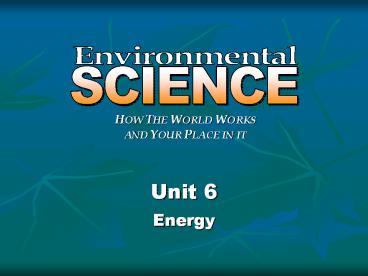Energy - PowerPoint PPT Presentation
1 / 7
Title:
Energy
Description:
HOW THE WORLD WORKS AND YOUR PLACE IN IT Unit 6 Energy Oil and Gas Deposits Secondary Recovery Methods Simplified Diagram of an Oil Refinery Fossil Fuel (Coal) Power ... – PowerPoint PPT presentation
Number of Views:55
Avg rating:3.0/5.0
Title: Energy
1
Unit 6
Environmental
SCIENCE
HOW THE WORLD WORKS AND YOUR PLACE IN IT
- Energy
2
Oil and Gas Deposits
A source rock is a rock that is rich in organic
matter. A reservoir rock is a rock that contains
many tiny pores with connecting passageways
through which the oil and gas can move. A trap,
or rock without pores, forms a dam or a lid that
keeps the oil and gas from escaping. This lid
must be tightly sealed in order for oil and gases
to collect in the reservoir.
3
Secondary Recovery Methods
Acid is injected into the well to dissolve
channels in the rock.
This method involves pumping water, carbon
dioxide or other gases into the well to force the
oil toward the opening
4
Simplified Diagram of an Oil Refinery
The processing of crude oil begins with
distillation. The crude oil is heated to 650F
(340C). As the oil is heated, the vapors pass
through a series of perforated trays in a
fractionating tower. The different hydrocarbons
condense at different temperatures. The lighter
compounds condense near the top of the tower, and
the heaviest compounds condense at the bottom of
the tower.
5
Fossil Fuel (Coal) Power Plant
The first commercial electric generating station,
designed by Thomas Edison, burned coal to heat
water and produce steam. The steam turned the
turbines, and enough electricity was produced to
light 1200 street lamps.
6
Hydroelectric Power Plant
Hydroelectric power is produced when the energy
of falling water turns a water turbine.
7
Nuclear Power Plant
The fuel used in nuclear power plants is mainly
uranium. When the uranium atoms fission or split
apart, they release huge amounts of energy. This
energy heats water and creates steam that drives
the turbines.































